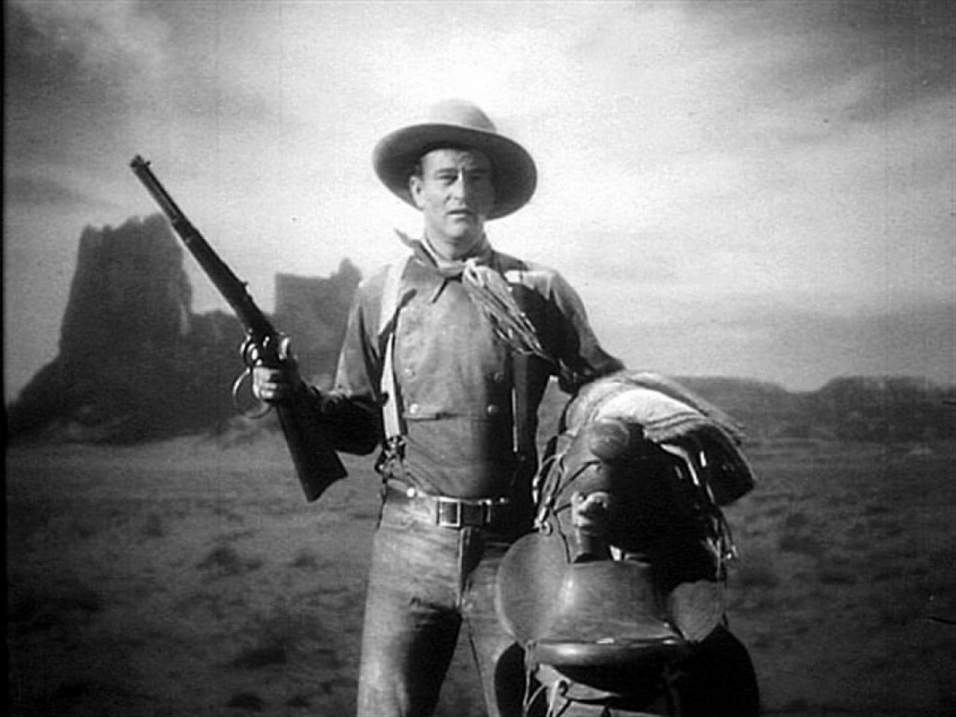
STAGECOACH: THE PAINTINGS
At 18 minutes 30 seconds into John Ford’s 1939 film, STAGECOACH, a stagecoach, with a group of motley passengers, is seen heading into a desert under threat of a hostile Indian uprising. At the sound of a gunshot there is an abrupt cut and the Ringo Kid (John Wayne) with upraised rifle, carrying a saddle, and squinting into the sun, stops the stagecoach, climbs to a seat beside the driver and becomes a passenger for one of cinema’s most iconic trips.
STAGECOACH: THE PAINTINGS is a series of twenty-four sequential paintings based on the twenty-four consecutive frames of film - exactly one second of movie time - which immediately follows the 18 minute 30 second cut. Change is little from one frame to the next, but, during this one second, the camera moves ever so slightly towards the Ringo Kid while his rifle makes a complete revolution as it recocks.
The concerns of STAGECOACH: THE PAINTINGS are several. Obviously, the myth of the frontier and its impact on culture and politics is of primary importance. Using popular culture’s most persuasive medium – the motion picture – Ford seemed to codify this myth into one of its most complete and defined forms. Arguably, with this film, at this frame, the myth found its most successful embodiment : John Wayne. The series of paintings also continues my ongoing interest with the language of painting as it relates to other forms of communication. Working in an age which processes information in brief factions of a second, there is, for me, a level of meaning in spending months giving physical existence to images which were never intended to be seen individually but only as impermanent flickers of projected light. This meaning I have yet to fully fathom.
I wish to acknowledge support received from the Virginia Commission for the Arts which partially funded this project.
At 18 minutes 30 seconds into John Ford’s 1939 film, STAGECOACH, a stagecoach, with a group of motley passengers, is seen heading into a desert under threat of a hostile Indian uprising. At the sound of a gunshot there is an abrupt cut and the Ringo Kid (John Wayne) with upraised rifle, carrying a saddle, and squinting into the sun, stops the stagecoach, climbs to a seat beside the driver and becomes a passenger for one of cinema’s most iconic trips.
STAGECOACH: THE PAINTINGS is a series of twenty-four sequential paintings based on the twenty-four consecutive frames of film - exactly one second of movie time - which immediately follows the 18 minute 30 second cut. Change is little from one frame to the next, but, during this one second, the camera moves ever so slightly towards the Ringo Kid while his rifle makes a complete revolution as it recocks.
The concerns of STAGECOACH: THE PAINTINGS are several. Obviously, the myth of the frontier and its impact on culture and politics is of primary importance. Using popular culture’s most persuasive medium – the motion picture – Ford seemed to codify this myth into one of its most complete and defined forms. Arguably, with this film, at this frame, the myth found its most successful embodiment : John Wayne. The series of paintings also continues my ongoing interest with the language of painting as it relates to other forms of communication. Working in an age which processes information in brief factions of a second, there is, for me, a level of meaning in spending months giving physical existence to images which were never intended to be seen individually but only as impermanent flickers of projected light. This meaning I have yet to fully fathom.
I wish to acknowledge support received from the Virginia Commission for the Arts which partially funded this project.